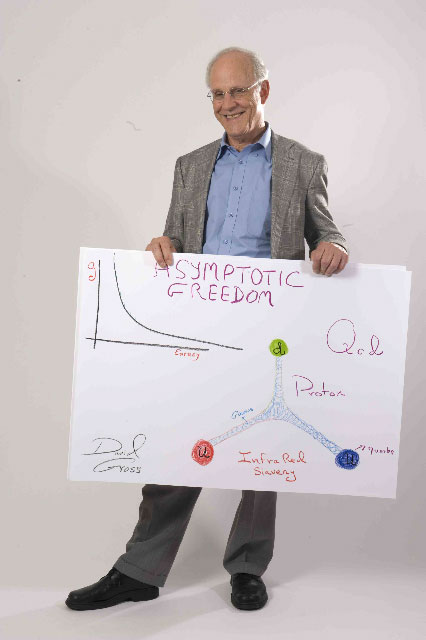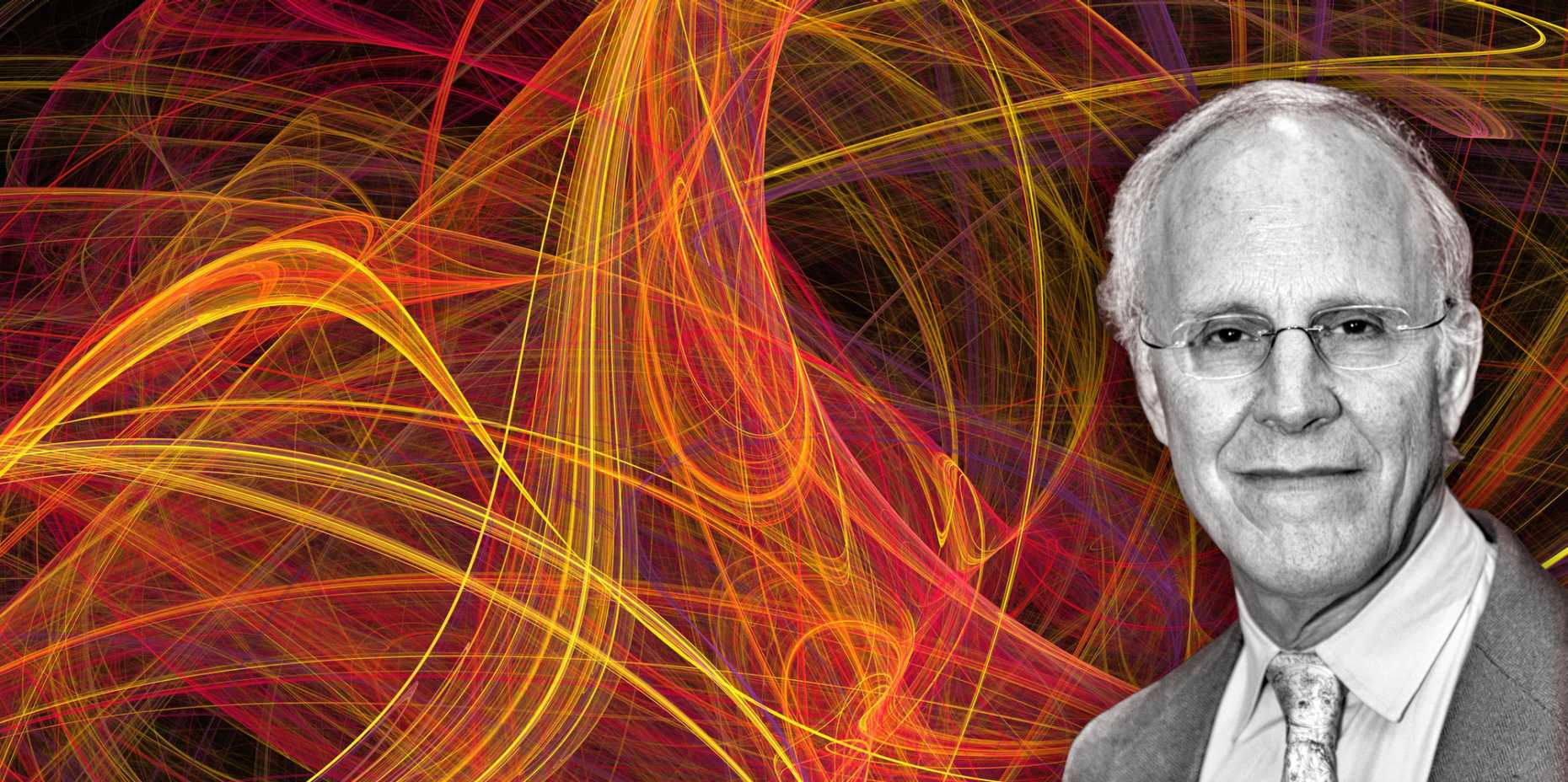From the nucleus to CERN or the colours of freedom in particle physics
What do the smallest particles locked up in protons have to tell us about how the universe began and how it will end? This week, physics Nobel laureate David Gross will present three public lectures at ETH Zurich on the theme “A Century of Quantum Physics – from Nuclear Physics to String Theory and Beyond”.
Some very strange-sounding things happen in the innermost core of atomic nuclei: when two particles come close together, the force between them becomes weaker rather than stronger. Conversely, the interaction between them grows stronger as they move apart. Like a rubber band holding two balls together, this force binds the two particles together and holds them in the atomic nucleus.
Physicists call this force the “strong interaction” and it is one of the four fundamental interactions that determine the behaviour of bodies, fields, particles and systems. The other three fundamental interactions are the weak interaction, electromagnetism and gravitation.
The effects of asymptotic freedom
Intuitively, the strong interaction contradicts the experience that people have in everyday life. Even for physicists, the phenomenon now referred to as “asymptotic freedom” was long regarded as a paradox – until 1973. That’s when David Gross, David Politzer and Frank Wilczek succeeded in demonstrating that a particular class of theories was the correct one to describe the strong interaction and asymptotic freedom. For their work, the three received the Nobel Prize in Physics 2004.
“This theory and the predictions that it enables were an important step in completing the standard model of particle physics,” says Charalampos Anastasiou, ETH Professor of Theoretical Particle Physics. The standard model describes the elementary particles and the interactions between them.
“Gross’ research was instrumental in enabling the more precise understanding of particles that we have today. This also furthered the research with the LHC particle accelerator at the CERN nuclear research centre,” says Anastasiou, whose theoretical work and mathematical models have contributed to the understanding of the properties of the Higgs boson particle. The existence of the particle was demonstrated experimentally by the physicists using the Large Hadron Collider in 2012.
“The past century saw the completion of a theory of atomic and nuclear matter. This theory is remarkably successful".David Gross
Now Gross is coming to ETH Zurich. As the speaker for the Paul Bernays Lectures, he will discuss in a general way how particle physics has developed over the past 100 years – from nuclear physics to string theory and beyond. “The past century saw the completion of a theory of atomic and nuclear matter based on quantum mechanics and relativistic field theory,” says Gross. “This theory is remarkably successful and has endured decades of precision tests. It is perhaps surprising that these basic principles, formulated almost a century ago, have been so robust and powerful.”
Physics with a philosophical bent
The Paul Bernays Lectures are an honorary lecture series hosted jointly by the ETH departments of Humanities, Social and Political Sciences, Mathematics and Physics. The series is dedicated to the philosophy of logic, mathematics and physics, and invites outstanding scientists whose work has embodied and advanced the foundations, methods and concepts of the exact sciences.
“David Gross exemplifies this combination of fundamental research in the field of physics and relevance with respect to the philosophy of science; he has introduced theories and concepts in particle physics that have played a decisive role in shaping our current understanding of material reality,” says Norman Sieroka. The ETH philosopher is a member of the Committee for the Paul Bernays Lectures and author of the book Philosophie der Physik.
Indeed, the discovery of asymptotic freedom and the theoretical work by Gross have shed considerable light on the history of particle physics and how it developed and established itself from the earlier nuclear physics after World War II. Physicists had known since 1911 that atomic nuclei were composed of protons and neutrons and surrounded by an atomic shell of freely moving electrons.
The clue of “colour charge”

In the 1960s, a spate of surprising scientific results began to emerge that could not be explained theoretically, as Gross elucidated in his Nobel Prize acceptance speech in 2005. The explanation was found by Gross, his colleagues and other physicists at the next lower level in the atom, where the nuclear forces are at work that allow atomic nuclei to form in the first place – and that ultimately allow material to exist over time in nature rather than disintegrating immediately.
On this deeper level, the protons and neutrons themselves consist of particles – quarks and gluons. The strong interaction “locks” the quarks in the interior of the proton and keeps them so close together that the protons become stable. The reason for this is a property of the quarks and the gluons referred to by physicists as the “colour charge”. The theory that describes the strong interaction between particles is called “quantum chromodynamics”, or QCD for short. It is one of the quantum field theories and is part of the standard model of particle physics.
Strings and the great unification
The standard model describes the particles and interactions. It is, however, incomplete: it does not encompass gravitation. The question arises as to whether and how a unified theory could be formulated.
The question exercises Gross as well: “The most challenging questions facing fundamental physics today are: How can we unify all the forces of nature including gravity? Will our most fundamental concept of physical reality, namely that of space-time, change and how? Can we understand how the universe began and how it will end?”
“Today, the most promising candidate for a theory that can unify all four fundamental forces is string theory,” says Anastasiou. Gross has been at the forefront of this development as well. The first string theories were devised in the 1960s in an effort to describe the strong interaction, but these efforts proved unsuccessful. However, in the 1980s Gross was able to demonstrate for the first time that string theory could in principle describe all known elementary particles.
“Gross has thus contributed significantly to the boom in string theory and to the fact that it is taken seriously,” says Anastasiou, who, like Sieroka, is looking forward to hearing how Gross views the future development of particle physics.
Paul Bernays Lectures 2017
A Century of Quantum Physics – from Nuclear Physics to String Theory and Beyond
They will be held by Prof. David Gross, Nobel Prize in Physics 2004, University of California, Santa Barbara (USA).
All lectures will take place at ETH Zurich, main building, Auditorium F 3, Rämistr. 101, 8006 Zurich:
Lecture 1: A Century of Nuclear Physics
Tuesday, 12 September 2017, 5pm
Lecture 2: Quantum Field Theory: Past, Present, Future
Wednesday, 13 September 2017, 2.15pm
Lecture 3: Gauge – Gravity, or Open – Closed String Duality
Wednesday, 13 September 2017, 4.30pm
All lectures are given in English and are self-contained. Lecture 1 is aimed at a general audience; lecture 2 and 3 address the scientific community.
Further information can be found at www.ethz.ch/bernays
References
Gross DJ: The discovery of asymptotic freedom and the emergence of QCD. PNAS, 2005, 102: 9099–9108, doi: external page10.1073/pnas.0503831102call_made.
Anastasiou C, Duhr C, Dulat F, Furlan E, Gehrmann T, Herzog F, Lazopoulos A, Mistlberger B: High precision determination of the gluon fusion Higgs boson cross-section at the LHC. Journal of High Energy Physics, 2016, 5: 1-101, doi: external page10.1007/JHEP05(2016)058call_made
Sieroka N. Philosophie der Physik. Eine Einführung. C.H. Beck, 2014.

